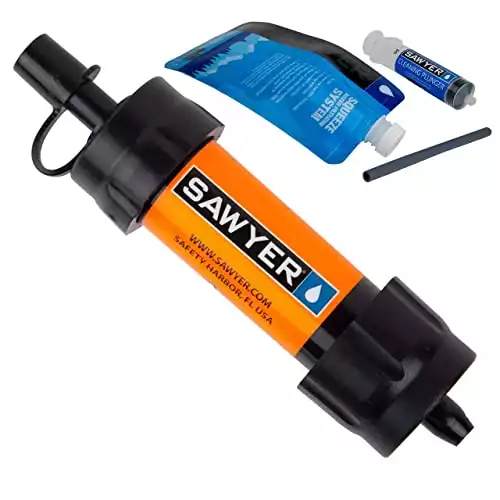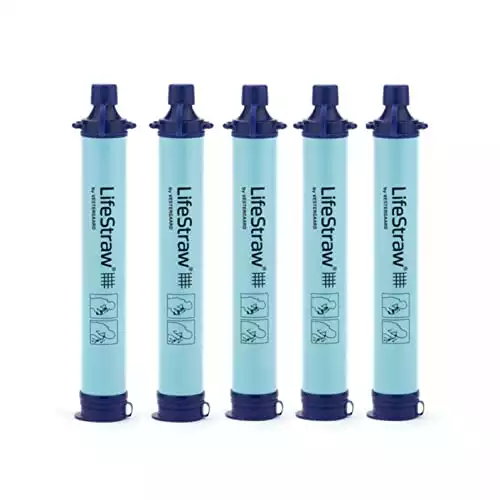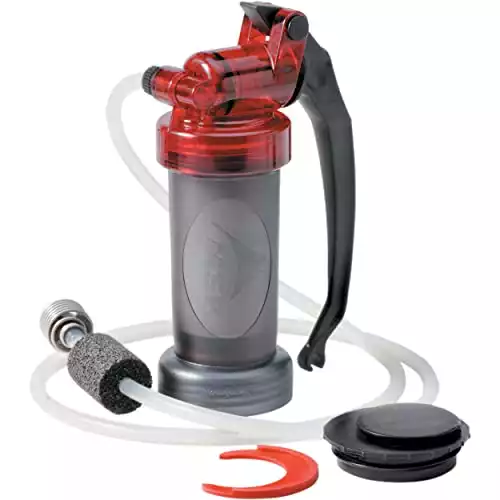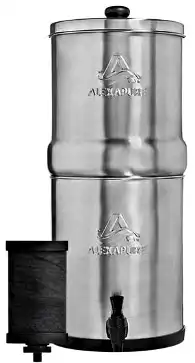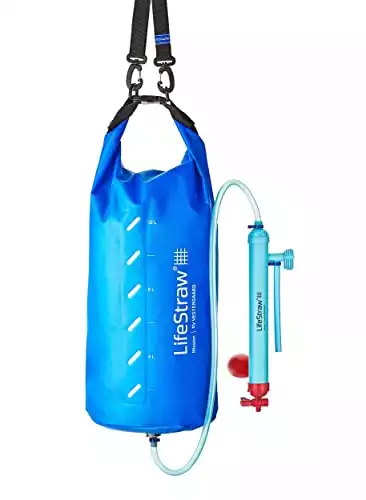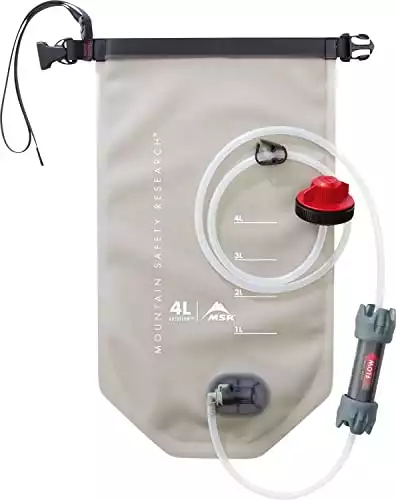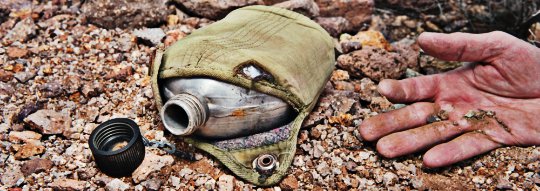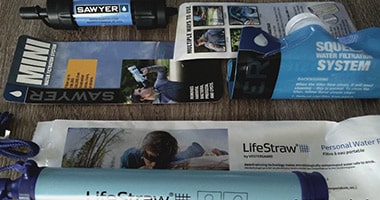
If you have to list the most critical resources in your survival plan, water will always be in your top 3.
Just think about all the ways you use water in your daily life:
- Drinking / Bathing
- Flushing / Brushing
- Cooking / Cleaning
These are tasks we perform EVERY single day!
Now imagine, for one minute, it’s gone. Taps dry… You can’t flush your toilets. You can’t bathe. But more importantly, you couldn’t quench your thirst.
The dehydration countdown would begin. You’d be forced to find a different source of water.
And while the image of a crystal clear, pure mountain stream sounds appealing, the reality is likely far different in a survival situation.
When you’re in survival mode, you may have to consume water wherever you can find it –
- muddy puddles
- algae-filled ponds
- livestock tanks
- river runoff
- roof runoff (i.e., rainwater harvesting)
These sources can be saturated with all kinds of bacteria, viruses, and chemicals. You need a way to remove these dangerous contaminants for drinking and cooking.
You need a survival water filtration action plan.
So today, we’re going to cover the following survival water filter topics in detail:
- Best Inline Survival Water Filters
- The Best Small Group Water Filters
- Best Large-Scale Water Filters
- 3 Different Types of Survival Water Filters
- Filtration vs. Purification
- Critical Survival Water Filter Factors
- The Best DIY Gravity Water Filters
- Water Filtration Best Practices
- Survival Water Action Plan
As A Way To Introduce You To Skilled Survival, We’re Giving Away Our Ultimate Survival Gear Checklist. Click Here To Get Your FREE Copy Of It.
Best Inline Survival Water Filters
For most, the first line of defense in water treatment systems is a personal filter to care for their own needs.
Everyone should have a personal filter in their pack at all times, even if they’re traveling with a group. If your group needs to split up, you don’t want to lose anyone without access to water treatment.
With the ultra-lightweight options nowadays, there’s no excuse.
Everyone should add some water filtration insurance to their pocket or pack.
Sawyer MINI Water Filtration System
I’ve recently become a big fan of the Sawyer Mini Filter.
This tiny water filter can process up to 100,000 GALLONS of water through a 0.1-micron filter.
Unlike the LifeStraw, the Sawyer Mini has hose adapters on either side. This design allows you to use a large variety of water retrieval options.
For example:
- Splice it into your hydration pack
- Convert it to a gravity filter
- Use a small piece of hose to gather water out of a small crack
Plus, it has a threaded end that screws onto a small bladder (or any soda bottle) to let you filter and drink on the move.
It also only weighs 2oz and is only 4″ long.
Again, it’s an excellent survival water filter for daily use or emergencies.
LifeStraw Personal Water Filters
In the past, we’ve detailed the LifeStraw personal straw filter.
These are impressive little filters that can treat up to 1000L of water. Using a LifeStraw is as simple as, well, drinking from a straw.
Their 0.2-micron filter material is effective against waterborne bacteria and parasites. Plus, they don’t need any extra chemicals or moving parts to function.
They’re only 2oz, and just under 9″ long, so they fit in any corner of your pack – or even a coat pocket. And, at this incredible price, they’re easy to stock up on for a group.
However, The LifeStraw isn’t the only personal filter on the market.
As A Way To Introduce You To Skilled Survival, We’re Giving Away Our Ultimate Survival Gear Checklist. Click Here To Get Your FREE Copy Of It.
Best Small-Group Water Filters
A personal water filter alone may not be practical when you go from a single person to a group. In this case, it’s often helpful to transition to a pump-style water filter or purifier.
They are typically about the size and weight of a 1L water bottle.
This weight increase makes it harder to carry, and it’s not practical for everyone in a group to have one.
But with a group, you can share and distribute the weight of other supplies. One person can carry the group water filter while another packs more food. This distribution helps the group to even out-pack weights accordingly.
There is a wide range of filter options on the market, from the simple sub-$100 filters to more advanced purifiers costing over $300.
It comes down to understanding your survival needs and the likely conditions you’ll encounter.
MSR MiniWorks EX Backountry Water Filter
On the less expensive end is the MSR MiniWorks EX purifier system. This system combines a filter and a purifier for better virus protection.
Plus, the MSR MiniWorks (and most MSR products) commit to designing field-serviceable equipment.
In this case, you can disassemble the entire filter without tools. A toolless disassembly allows you to clean and replace the filter core anywhere.
In fact, regular cleaning of the surface of a ceramic filter core (via a scrub pad) helps keep the water flowing.
The filter/purifier cartridge is good for about 2000L, after which you’d have to replace it with a fresh one.
While the cost of entry is low, the filter replacement costs will add up over time. Filtration costs are even more of an issue if you depend on the MSR MiniWorks for everyday use.
Also, the two-step treatment workflow is a bit clunky. However, you can decide whether you feel virus treatment drops are necessary. Then conserve them for the times they seem justified.
The MSR MiniWorks EX purifier is ideal for small group water treatment. Perfect as a temporary portable filter (traveling to a cabin) that won’t see a ton of use and you’re on a tight budget.
MSR Guardian Water Purifier
For longer-term and worst-case water situations, check out the MSR Guardian purifier. It’s another decent option, though it is a bit more expensive.
The Guardian is a mechanical filter purifier.
Mechanical filters don’t rely on any added chemicals. It uses a tiny filter pore size (10x smaller than the MiniWorks EX). And this filter removes microscopic viruses from the water.
In the past, mechanical purifiers were incredibly quick to clog with sediments.
But MSR has found a way to deal with this limitation. They now divert 10% of the water on each pump stroke to flush the filter element.
I’ve heard stories of people returning their Guardian because they pumped too easily! The users couldn’t believe the water was actually going through the filter.
Having used one on a couple of trips, it certainly made me double-check at first as well.
This design allows the Guardian to remove the tiniest viruses without sacrificing flow rates.
In fact, it maintains flow rates more than double what you find in comparable filters. So when you’re filtering for a large group, that equates to a LOT of saved time and effort every day.
If your group plans to be on the move and encounter suspect water sources, the MSR Guardian is an excellent survival water filter.
This massive volume helps to offset much of the cost difference.
As A Way To Introduce You To Skilled Survival, We’re Giving Away Our Ultimate Survival Gear Checklist. Click Here To Get Your FREE Copy Of It.
Best Large-Scale Water Filters
In the world of survival, having a permanent (or even semi-permanent) camp is indeed a luxury.
But, with a good plan and essential camping equipment, it’s a great way to conserve resources and energy.
On a long trip, even a single no-travel day can feel like a vacation from the everyday routine of breaking camp.
With larger groups, one of the first resources to secure is an abundant clean water supply.
Sure, you could sit and pump gallons and gallons of water through a hand-held filter. But it’s far more efficient to set up a gravity filter.
A gravity filter allows you to do other camp chores while your water takes care of itself.
AlexaPure Countertop Gravity Water Filters
Yes, they are more expensive, bulky, and heavy. But they can withstand years of daily use with only occasional filter changes.
They also provide convenience at the flip of a spigot.
If your survival shelter is permanent, check out AlexaPure. These units have become popular in homes as everyday modern kitchen appliances.
These gravity filters consist of stacked stainless steel reservoirs and high-quality ceramic filters.
But with a sleek stainless steel container, they can look great sitting on your countertops.
You wouldn’t want to hand a dry bag and inline filter up in your kitchen for everyday use, right?
LifeStraw Mission High-Volume Gravity-Fed Water Purifier
One of the more portable gravity filters, the LifeStraw Mission purifier. This unit combines a 0.02-micron filter purifier (0.02 not 0.2) with either a 5L or 12L reservoir.
The reservoir is like a dry bag, with a roll-top seal and a hose port on the bottom.
The LifeStraw Mission also contains a handy pre-filter. That way you can use murky water but remove the larger sediments to prevent clogging of your primary filter.
From there, the water flows through a modified version of the LifeStraw filter. But, unlike the LifeStraw, this model includes a backwash valve for cleaning.
The LifeStraw Mission system gives you up to 3 gallons of fresh water per hour. That 3 gallons with no effort on your part except to fill the reservoir and hang it.
When not in use, the whole system packs down into a small stuff sack and weighs less than a pound. It’s a tremendously useful turn-key system.
The LifeStraw Mission is an inexpensive way to provide bulk amounts of filtered water for a group camp.
MSR AutoFlow Gravity Water Filter
Another gravity filter option is the MSR AutoFlow.
This unit provides much higher flow rates (1 gallon in about 3 minutes) through a 0.2-micron filter.
But that high flow rate comes at the cost of virus protection.
If you’re in a pristine environment in the wild, the MSR AutoFlow is a great option for filtration.
3 Different Types Of Survival Water Filters
There are 3 main types of survival water filters. Each type works best for different situations and setups.
So let’s quickly go over them in general now. Then we’ll review what we consider the best water filters for survival later.
1. In-Line Water Filter
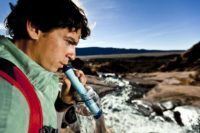
Think of them as a large straw where the easiest way to use one is to suck (just like a straw).
The sucking action pulls water through the interior filter medium and removes harmful contaminants. Simple but effective.
The ones we will be covering later (Sawyer Mini Water Filter & LifeStraw) are both lightweight, portable, packable, and ideal for a single person on the move.
2. Hand Pump Water Filter
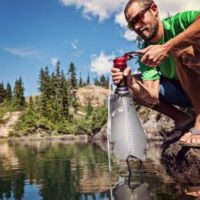
Instead, they are built with hand pumps.
The pumping action pulls water through the filter medium to clean the water of contaminants.
Hand pump water filters are larger than inline personal filters. Not too big to pack and carry but bigger and slightly heavier. They can also process more water faster than inline filters.
So they are ideal for small to medium sized groups on the move.
3. Gravity Fed Water Filter
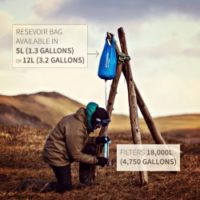
That’s because gravity filters are passive. You set them up and let them work via gravity while you go away and do other things.
You don’t have to suck or pump to filter the water; gravity does this for you.
Again, the filter doesn’t have to be large, but the setup is. So this type of filtration system is not ideal for travel.
Heck, many of the popular gravity-fed systems are not mobile at all and are better suited for a countertop.
Due to the passive filtering and the setup size, gravity-fed water filtration systems are best for large groups who are staying put.
As A Way To Introduce You To Skilled Survival, We’re Giving Away Our Ultimate Survival Gear Checklist. Click Here To Get Your FREE Copy Of It.
Filtration Vs. Purification
First, a little terminology lesson.
I’m going to be very deliberate with my use of two words. So pay attention because they mean very different things in the world of water treatment.
Term 1 – Filters
“FILTERS” are mechanical devices that remove particles from the water.
They’re rated by the LARGEST particle size that can pass through the filter pores.
Most filters are rated in microns (1/1000000th of a meter). So a 0.2-micron filter can safely remove the majority (i.e., 99.999%) of bacteria, protozoa, and sediments.
Term 2 – Purifiers
“PURIFIERS” may or may not remove particles. Instead, they render dangerous contaminants inactive.
Purifiers add a layer of protection against viruses. It kills viruses that could slip through all but the smallest filters.
You can purify water through the use of UV light, chemicals, or mechanical filtration.
Also, some purifiers contain secondary treatment (usually activated carbon or chlorine). These secondary treatments remove dissolved chemicals, taste, and odor.
In today’s article, we primarily focus on water filtration; you should also check out our water purification article.
The bottom line is that the simplest, most cost-effective two ways to purify water are to
- boil it or
- add water purification tablets to it.
As A Way To Introduce You To Skilled Survival, We’re Giving Away Our Ultimate Survival Gear Checklist. Click Here To Get Your FREE Copy Of It.
Critical Survival Water Filter Factors
There are a lot of factors that go into the selection of the right water filter system for you.
You have to think and plan for future use. Remember that your needs may change over time and as you travel, so it’s often best to have a couple of options available.
Also, I always have backups for emergencies for such a critical resource as water.
With this in mind, here are the most important aspects to consider in your search for the perfect survival water filter.
Source Water Quality
The most important factor in choosing a water treatment system is; “What do you need to remove from my water?”
You’ll need very little treatment if you’re near the water source (i.e., glaciers, cold springs, snowmelt).
In these locations, the water is mostly pure. It has had little chance of becoming contaminated with bacteria and viruses.
These situations are ideal for a basic water FILTER.
But, if you’re filtering near farms, cities, or swamps (where most of us live), contamination is more likely. Upstream human activity has probably contaminated the water to some degree.
So you’ll need more and better treatment than a basic filter.
You’ll also want to purify the water to remove viruses, chemical runoff, and any bad tastes and odors.
Group Size
Another critical factor is the size of the group you plan to provide with clean water.
If you only have to supply for your own needs, you may be able to get by with a lightweight inline filter or filter straw.
They’re cheaper, lighter, and take up less space in your pack.
A personal filter no longer makes sense if this expands to a small party (2-5 people). Instead, you’d be better served by a small pump water filter.
They’re faster for filling several water bottles, and you can take turns pumping water.
Gravity-fed filters are a good option if you plan to make camp in one place for a while. They remove much of the slow effort of water treatment. They can provide gallons a day if someone keeps adding raw water.
The downside is they’re bulky and sometimes heavy. But you can’t beat the convenience of water at the turn of a tap in camp.
Weight and Size
Many of our survival plans involve being mobile, even if only while we make our way to a bug-out location.
The smallest in-line filters weigh nearly nothing and can fit in the tiniest of pockets. But, as you move into larger systems, the weight and pack size can add up.
The larger pump style and gravity filters are great options for a cabin or vehicle but won’t work in a pack.
It all comes down to weighing the technology against your needs. To develop your survival water filter plan, you’ll need to understand the tradeoffs.
Price
Finally, we all know quality survival gear doesn’t come cheap.
When comparing water treatment systems, be sure to check the specifications carefully. Two seemingly similar filters can have wildly different prices.
There’s a significant difference between a 1-micron “filter” and a 0.2-micron “purifier.” They are different regarding function and cost, even if they come in similar packaging.
That said, sometimes, a simple filter is all you need. In these cases, paying more for a high-tech purifier leaves you with less for other supplies.
As A Way To Introduce You To Skilled Survival, We’re Giving Away Our #78 Item Complete Prepper Checklist. Click Here To Get Your FREE Copy Of It.
Simple DIY Gravity Filter
Of course, there are those out there who want to keep costs to a minimum and aren’t afraid of DIY.
If that sounds like you, building a gravity filter from a Sawyer Mini is simple.
There are several ways to set up a gravity filter, but they almost all use the following:
- an elevated reservoir (a bucket, bladder, or tank)
- a length of tubing
- an inline filter (like the Sawyer Mini)
- a second reservoir for clean water
Seriously, that’s it!
Plumb a valve into the bottom of a 5-gallon bucket (large elevated reservoir). Then attach several feet of hose to your inline filter. Let the water drip into a second 5-gallon bucket (or bottle, or whatever).
Voila! You have a simple, inexpensive gravity filter.
The greater the elevation between the reservoir and the filter, the more pressure.
Head pressure is what’s required you need to force the water through the filter element. The good news is a few feet is usually enough, but more will help to increase the flow rate.
A simple gravity filter can filter at the same rates as the commercial version at a fraction of the cost.
As A Way To Introduce You To Skilled Survival, We’re Giving Away Our Ultimate Survival Gear Checklist. Click Here To Get Your FREE Copy Of It.
Water Filtration Best Practices
No matter what type of water treatment system you choose, some best practices exist.
Techniques you should use to make it work as smoothly and efficiently as possible. These best practices should become simple habits when you’re filtering and treating water.
Water Source Selection Matters
First off, this is critical, don’t make your filters do any more work than they have to.
Try to find the cleanest, most transparent water available to you. Avoid muddy water and water with visible pollution if at all possible.
The manufacturer’s filter ratings are all based on a generic “bad” water specification. But that’s usually much cleaner than something like a stirred-up muddy puddle.
The more material you put into your filters, the faster the pores will clog. Soon you’ll notice a drop in flow rates and an increase in the effort to move water through the filter material.
Eventually, they’ll clog so severely that you won’t be able to use the filters at all.
Sometimes you don’t have any options though, and this is where pre-filtering your water can help.
I keep a small piece of filter sponge, a survival bandana, and some elastic hair ties with my water filter. That way, when I encounter silty water, I always have a prefilter with me.
I place the filter sponge over the filter inlet to prefilter the small debris. Then I cover it with at least one layer of the bandana and wrap the whole thing with a hair tie.
This setup creates a DIY prefilter to remove the sand, muck, and leaves before it enters the filter inlet.
The pre-filter reduces the work my filter element has to do and extends the filter’s useful life.
Avoid Cross-Contamination
One common mistake I see people make with water treatment systems is cross-contamination.
They allow raw water to drip onto the clean water end of the filter. This means the contaminants can pass on to your next batch of treated water.
This is why most commercial filters have clear labels or color codes to determine which end is which. Many also include protective rubber caps for both ends to reduce leakage after use.
If you’re careful not to cross-contaminate, you reduce your risk of waterborne illnesses.
Take Time To Learn Maintenance
Take the time to read and follow the maintenance instructions for your treatment system.
Many hollow-tube filters (LifeStraw, Sawyer, MSR Guardian) are susceptible to freezing. If you leave trace amounts of water in them during sub-zero temps, they will not work again until they thaw.
Others with ceramic filters can crack if frozen.
Some need to be flushed with clean water after each use. Others only require this if you plan to store the filter for extended periods.
Some filters need to be scrubbed instead of flushed to prevent clogging. Other systems do it automatically.
Don’t skip them to save a couple of minutes.
As A Way To Introduce You To Skilled Survival, We’re Giving Away Our #78 Item Complete Prepper Checklist. Click Here To Get Your FREE Copy Of It.
Survival Water Action Plan
As you can tell, there are a lot of options out there for water treatment.
From here, you’ll have to think about your survival water plan.
Remember, clean water is one of the most crucial elements of your survival plan. From cooking, cleaning, and staying hydrated, everything stops without life-giving H20.
As you can tell, there are a lot of options out there for water treatment.
These are just a few of the brands we’ve tried, but they represent a good cross-section of the market. We hope they show you how they work and their differences.
You’ll have a personal water filter with a massive 100,000 filter lifespan. You can also use it to create a simple group gravity water filter.
It’s the easiest, most cost-effective way to cover all your bases regardless of the type of emergency you’re dealing with.
From here, you’ll have to think about your survival water plan.
Remember, clean water is one of the most crucial elements of your survival plan. From cooking, cleaning, and staying hydrated, everything stops without life-giving H20.
There are many ways to ensure your plan doesn’t leave you without clean water. And I highly recommend a good backup (or two), just in case.
Honestly, if you want the most options at the best price, pick up a couple of Sawyer Minis. That way, you’ll kill two birds with one stone.
Jason K.
P.s. Are you ready for the tough times ahead?
Find out now by taking my short Readiness Score Quiz – it’s absolutely free.
Once complete, you’ll know exactly where you stand on the “fragile” vs.” resilient” spectrum.
So click here to start the Quiz….And don’t worry; the questions are so easy a 3rd grader could answer them.
Click on the image to begin the Quiz and find out once and for all if you’re part of “The Fragile Masses” or “The Resilient Few.”
The post 7 Best Survival Water Filters For Removing Dangerous Particulates appeared first on Skilled Survival.



